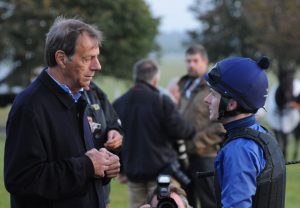To all intents and purposes, the 2014 Flat racing season has not yet begun in Europe – but already it has lost a little bit of its magic with the announcement on Tuesday that the great jockey Johnny Murtagh has hung up his boots at the age of 43.
To many, it will be incomprehensible that Murtagh could have called it a day at this point, because he was riding in the very peak of his form throughout 2013 and had no shortage of good horses to ride. However, since last summer he has been combining training with race-riding and, ever the perfectionist, he has decided that he cannot devote his full attention to both endeavours. So, looking to the future, henceforth he will concentrate solely on the training.
Born in Navan in Co. Meath, Ireland, in May 1970, Johnny Murtagh was an excellent schoolboy sportsman, being an Irish boxing champion for the under-14 age-group, and coming close to signing as an apprentice for English soccer club Blackburn Rovers. However, responding to the usual suggestion of, “You’re small – you should be a jockey” he enrolled at Ireland’s RACE apprentice academy at the Curragh, from which he was directed to the nearby stable of John Oxx.
Oxx has had several champion apprentices through his hands, but Murtagh will always remain his star pupil. Despite not having come from an equestrian background, the new recruit took to riding racehorses like a duck to water, and rode his first winner – Chicago Style at Limerick – aged 17. A successful apprenticeship ensued, followed by his appointment as stable jockey in 1992, aged 21. The combination flourished, to the extent that in 1995 season Murtagh won the first of his five Irish jockeys’ championships.
The same year saw Murtagh established on the international stage, courtesy of the stable’s superstar filly Ridgewood Pearl. The chestnut daughter of Indian Ridge was sublime that season, winning four Group 1 races. The first of these – the Irish 1,000 Guineas – came on home soil and ridden by the veteran hoop Christy Roche (while Murtagh finished third in the race on the stable’s other runner Khaytada, who was less fancied but was owned by the stable’s principal patron, the Aga Khan). Thereafter, though, she advertised her merit to a wider audience – and she did so with Murtagh in the saddle every time.
Murtagh’s first Group 1 victory on Ridgewood Pearl came in England, in the Coronation Stake at Royal Ascot. Come the autumn, the pair struck gold in France in the Prix du Moulin du Longchamp, before ending the year in a blaze of glory in America, taking the Breeders’ Cup Turf in New York.
Having been propelled into the limelight by Ridgewood Pearl, Murtagh has stayed there ever since. Thanks largely to the Aga Khan, John Oxx began to find top-class horses appearing in his stable more regularly. The threesome tasted Grade 1 glory in the United States in 1996 with the great racemare Timarida, while bigger victories waited just around the corner.
In 1999, Murtagh and Oxx combined to win the Ascot Gold Cup for the Aga Khan with Enzeli, as well as taking Ireland’s premier juvenile race, the National Stakes, with his Grand Lodge colt Sinndar. Even better was to follow the next year when Sinndar proved himself Europe’s champion by landing the Derby, Irish Derby and Prix de l’Arc de Triomphe.
The culmination of that Group 1 treble was a mighty day indeed for the trainer and jockey because they also took out the Group 1 sprint on the same Longchamp card, snaring the Prix de l’Abbaye with Namid.
The Aga Khan link saw Murtagh starting to pick up rides for Sir Michael Stoute, not just on Aga Khan-owned horses (such as Kalanisi, whom he rode to victory in both the Champion Stakes and Breeders’ Cup Turf in 2000) but on a broad cross-section of the stable’s stars, irrespective of their ownership, such as the outstanding Highclere-owned filly Petrushka. This link proved a lasting one, as did alliances forged with many other leading British stables.
By now, in addition to riding for Oxx, Murtagh was in line for mounts for Aidan O’Brien when Mick Kinane was not available. From this source came a stunning series of big-race victories which set the seal on Murtagh’s reputation as one of the weighing room’s true stars.
Aidan O’Brien ran four horses in the Irish 2,000 Guineas in 2001, with Mick Kinane riding the hot favourite Minardi and Jamie Spencer on board the second string Freud. This left two 20/1 shots to make up the stable’s team, one (Mozart) ridden by Seamus Heffernan and the other (Black Minnaloushe) ridden by Murtagh. O’Brien duly saddled the trifecta, but not in the order he expected, as Black Minnaloushe won.
It was the same story at Royal Ascot the following month, when Mick Kinane again opted to partner Minardi – only to get a rear view of Black Minnaloushe and Johnny Murtagh winning the St. James’s Palace Stakes.
The following year’s results were even more remarkable. Of O’Brien’s team in the 2,000 Guineas, Mick Kinane opted for Hawk Wing – only to finish second behind Murtagh on Rock Of Gibraltar. It was the same story in the Derby: Kinane again chose Hawk Wing and again finished second to a stable-mate, coming up short against the Murtagh-ridden High Chaparral. By now, Murtagh’s reputation as the big-race specialist was cast in stone.
Among the trainers who were using Murtagh by this stage were Mark Johnston (for whom he won the Ascot Gold Cup in 2001 and ’02 on Royal Rebel) and John Dunlop (whose Give Notice he partnered to victory in the Prix du Cadran in 2002). Furthermore, when Paul Perry sent Choisir on his ground-breaking expedition from New South Wales to England in the summer of 2003, Johnny Murtagh was chosen to ride the mighty chestnut, and a famous Royal Ascot sprinting double ensued. Oxx was continuing to come up with good horses for the Aga Khan, and 2003 saw him and Murtagh enjoying another golden summer courtesy of Alamshar, who beat the His Highness’ better-fancied French-trained colt Dalakhani in the Irish Derby before following up in the King George VI & Queen Elizabeth Diamond Stakes at Ascot.
Remarkably, at the end of that year Oxx and Murtagh parted company. This split was a surprise, but predictably it did not prove permanent – and it certainly didn’t halt the jockey’s run of success. Riding as a freelance for the first time in 2004, he teamed up with James Fanshawe to win four Group 1 races: three on Soviet Song, and the July Cup on Frizzante.
Better was to follow in 2005 when Murtagh was chosen by syndicate manager Harry Herbert to partner the Royal Ascot Racing Club-owned Montjeu colt Motivator. Michael Bell, trainer of Motivator, did not retain a jockey, and Murtagh was clearly the best freelance in Europe. A match seemingly made in heaven duly ensued as the pair followed up victory in the Dante Stakes at York by strolling home in the Derby.
During this period, Murtagh showed an extra dimension to his skill, riding over hurdles in the winter to keep himself fit and busy. He rode plenty of winners at an outstanding strike rate, and came within inches of recording Grade 1 victory on the Mick Halford-trained Golden Cross at the 2006 Cheltenham Festival.
Eventually, the inevitable happened: Murtagh became Aidan O’Brien’s stable jockey in 2008, the only suitable reflection being, “What took them so long?”. In fact, the pairing came about because of Kieren Fallon’s various disciplinary problems. Murtagh had ridden many of O’Brien’s runners in England (including winning the King George VI And Queen Elizabeth Stakes at Ascot on Dylan Thomas) in 2007 (in which year Fallon, the stable jockey, was permitted to ride in Ireland and France but not in Britain) before taking a retainer the following year when Fallon was banned worldwide.
Three glorious years ensued in which the combination swept the board with a seemingly endless supply of top-class horses. Brightest of these stars was surely the mighty Yeats, whom he partnered to victory in the Ascot Gold Cup in both 2008 and ’09. That latter victory, the great stayer’s fourth straight win in the race, left barely a dry eye in the Royal Ascot stands. Other triumphs in that golden era included Group 1 victories on the Coolmore’s Australian imports Haradasun and Starspangledbanner, a swag of weight-for-age triumphs on Duke Of Marmalade, a string of big-race success on the outstanding three-year-old milers Henrythenavigator, Mastercraftsman, and Irish Derby wins on Fame And Glory and Cape Blanco.
However, riding for the Coolmore team is a high-pressure job, and after three years Murtagh elected to resume his former freelance status. Being his own boss, though, didn’t last long as the Aga Khan snapped him up to ride his Irish string, which meant that he was back where he started: riding for John Oxx (as well as for Mick Halford, who by now had some horses for the Aga Khan).
What in retrospect we can now call a golden autumn for Murtagh ensued: his retainer provided him with a flow of winners, while he remained the most sought-after jockey for spare rides in Europe’s big races. His popularity is shown by the fact that, having won a fourth Irish jockeys’ title in 2009 when riding for O’Brien, he became champion jockey again in 2011 without the support of the country’s dominant stable.
An outstanding front-running ride saw Murtagh land a shock victory on the William Haggas-trained Dancing Rain in the 2011 Oaks, while 2013 proved a real annus mirabilis. Virtuoso performances saw him post Group 1 victories left, right and centre last year, with his skills never more evident than in the Irish Oaks on the Alain de Royer-Dupre-trained Chicquita or in the King George & Queen Elizabeth Diamond Stakes on the German raider Novellist.
By this time, though, Murtagh had set up his own stable on the Curragh. Initially he employed the former champion jump jockey Tommy Carmody to act as trainer, and the team tasted Group 1 glory when Royal Diamond (ridden by Niall McCullough) won the Irish St Leger in 2012.
As 2013 developed, though, it became clear that training was becoming an ever bigger part of Murtagh’s life, and last summer he took over the trainer’s license himself. This set the stage for a magnificent achievement at Ascot on British Champions’ Day last October. As well as riding a Group 1 winner for James Fanshawe in the British Champions Fillies’ and Mares’ Stakes on Seal Of Approval, he rode and trained Royal Diamond to a thrilling last-stride victory by a nose in the British Champions Long Distance Cup.
We can now call that triumph the curtain call of Johnny Murtagh, the great jockey. He will, of course, make plenty more visits to big-race winner’s enclosures in the future, but solely as trainer – with other, less talented, riders in his horses’ saddles.



